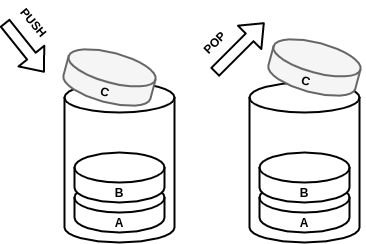A stack uses LIFO (last-in-first-out) ordering, the most recent item added is the first item to be removed, just like a real stack. Some uses of this data structure are expressions evaluations and conversion (prefix, postfix, and infix), backtracking, and memory management.

Representation
A stack can be implemented using an array or a linked list, can be either fixed or dynamic size.
Basic operations
- Push - Add an item to the top of the stack
- Pop - Remove the top item from the stack
- Peek - Return the top of the stack, without removing it.
- isEmpty - Return true if the stack is empty.
- isFull - Return true if the stack is full, used when the stack is fixed size.
Here's an implementation of a stack using an array, in TypeScript an array doesn't have a fixed length, so the operation isFull is not required, however, you can implement a stack with a fixed length and use that operation.
1class Stack<T> {
2 private array: T[] = [];
3
4 pop(): T | undefined {
5 if (this.isEmpty()) throw new EmptyStackException();
6
7 return this.array.pop();
8 }
9
10 push(data: T): void {
11 this.array.push(data);
12 }
13
14 peek(): T {
15 if (this.isEmpty()) throw new EmptyStackException();
16
17 return this.array[this.array.length - 1];
18 }
19
20 isEmpty(): boolean {
21 return this.array.length === 0;
22 }
23}

